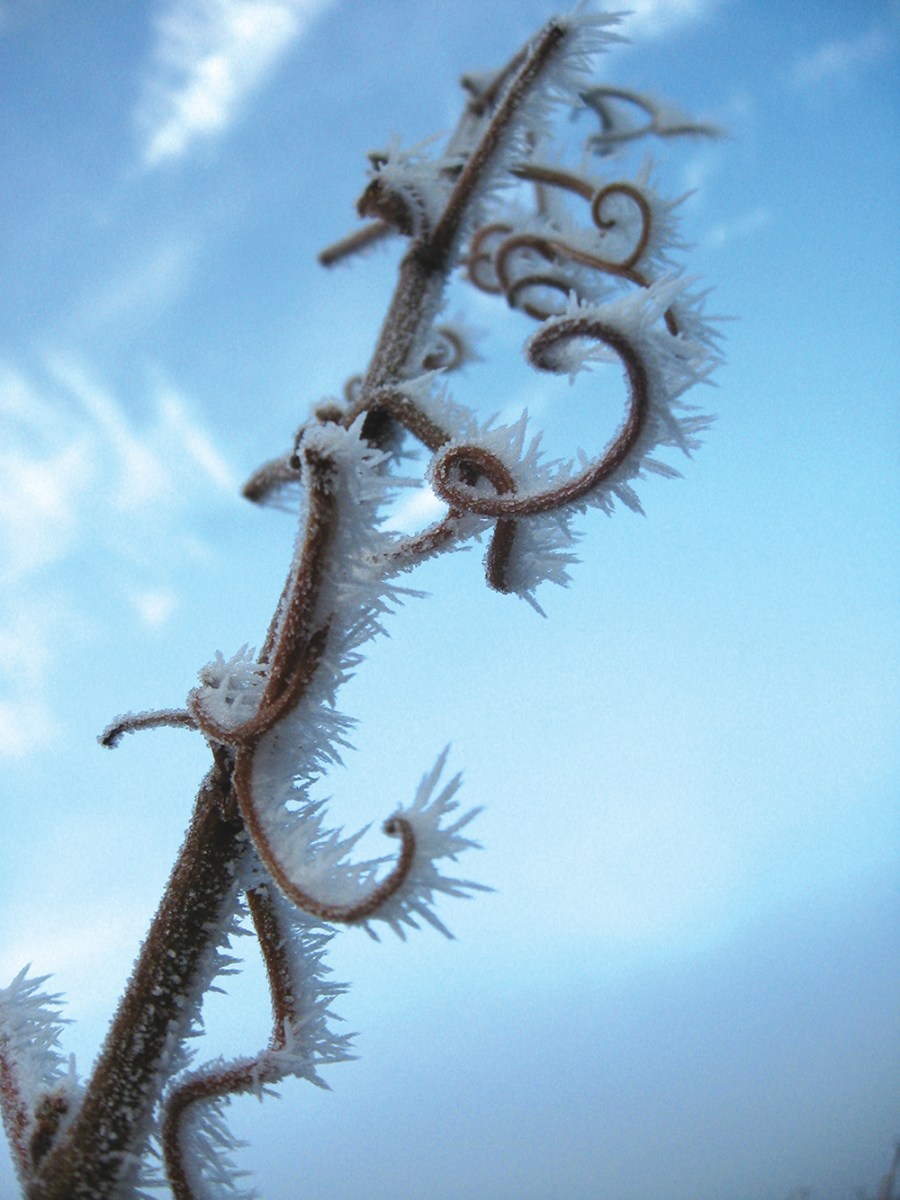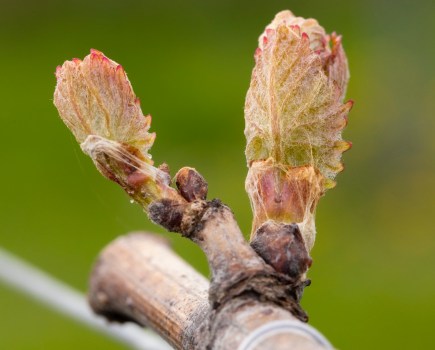As the new growing season starts, excitement and anticipation of the 2021 vintage begins, but is tempered by the many hurdles of grape growing in a cool climate – the first being a visit from Jack Frost! The late frosts in May 2020 were devastating for many vineyards, reducing their yields significantly. It is important to know your enemy and understand your frost risks. Vineyard asks: How does frost damage the vine? How can you predict when and where a frost will occur? How can you reduce the risk of frost? And what should you do if your vines are damaged by frost?
The 2020 WineGB frost survey, carried out by Stephen Skelton, head of the WineGB viticulture working group and Steve Wain from Mapman, recorded the impact of frost during the Spring. The survey received 198 separate frost reports, and 60% of these reported that they had no frost protection in place. According to the survey, for those that had protection, the most common methods were bougies (frost candles), followed by fans, and sprays.
“The first step is to estimate what the likely crop losses from frost are, and the value of the losses for example over a 10 year period, to decide how much it is worth spending on protection. There are passive measures which can be taken to reduce the level of frost damage, as well as several active methods, those requiring inputs of materials, machinery and labour during a frost event,” explains Stephen Skelton, viticulturist, Master of Wine and author of Wine Growing in Great Britain. “The best method of frost protection is to select a site that is not in a frost pocket. However, finding such a site is not always possible and you may find that your site has areas that are prone to frost where there are depressions or low-lying corners where the cold air can settle,” he added.
What is frost and what does it do to the vine?
Dormant vines over the winter are perfectly capable of withstanding the normal winter temperatures in the UK, but as soon as they start to wake up in the Spring and get to the ‘woolly bud’ growth stage, the young tissues become vulnerable. Different growth stages have different ‘critical’ temperatures. “The critical temperature is the point that 50% of buds or shoots are killed and it varies by phenological growth stage,” explains Dr Greg Dunn, head of Plumpton College, in Sussex’s wine department. “When the temperature drops below ‘critical’ ice crystals form inside cells and damage the cell contents, causing tissue death,” Greg added.
There is some minor variation between Vitis vinifera vine varieties in their tolerance of cold. “However, the main difference in frost susceptibility between cultivars is related to phenology, with some cultivars bursting later than others, thus being exposed to fewer frost events”, Greg continued.
How do you to predict when and where a frost will occur?
Reliable frost forecasts are essential for determining if frost control measures are needed, along with a good understanding of the likely frost pockets in the vineyard. But is it a radiation frost, a ground frost, air frost or even an advection frost? It’s important to know your enemy before starting the fight.
Professor Steve Dorling is a Viti-Climatologist at the University of East Anglia and Chief Executive of Weatherquest Ltd, a company specialising in supporting growers through weather and climate services. “There are two main types of frost, radiation frost and advection frost,” Professor Dorling explained.
“After sunset, very light winds, clear skies and a relatively dry ground all encourage the temperature of the ground surface to fall quickly, as it radiates energy away. These are the ingredients which increase the chances of a local radiation frost, when the temperature falls to 0°C or below. A breeze helps to mix warmer air, while a blanket of cloud is also very effective in intercepting the energy being lost, re-radiating it back to the ground. This can slow or even reverse the temperature fall. A wet soil will also cool more slowly – a recent wet spell or a soil type which holds moisture better will reduce the risk of radiation frost. In radiation frost conditions, the heavy cold air forming on vineyard slopes will naturally drain downslope and collect in relatively low-lying areas, especially when the cold airflow is impeded in some way,” he explained.
“By contrast, an advection frost is normally a more widespread event which results from a cold airmass covering the region with sub-zero temperatures. An advection frost event is more likely when we have a sustained period of winds from the north or east in winter or early spring. It is more difficult to protect against because a large cold airmass will not discriminate between sites,” he continued.
“Sensitive vine buds will typically be at heights between ground level and where air temperatures are routinely measured, at 1.5m to 2m. In radiation frost situations, overnight ground temperature can often be several degrees or more below the 2m air temperature, so great care is needed when referring to temperature forecasts – a ground frost is different to an air frost at 2m!”
Even a well selected site can be unfortunate enough to occasionally experience frost during critical growth periods, so vigilance at those times is especially important. “Alerts from strategically positioned weather sensors in the vineyard coupled with specialist weather forecast advice will allow you to plan ahead and take frost mitigation action,” said Professor Dorling. Weatherquest will launch the IceQuest service in the New Year in time for the 2021 bud-burst frost risk period.
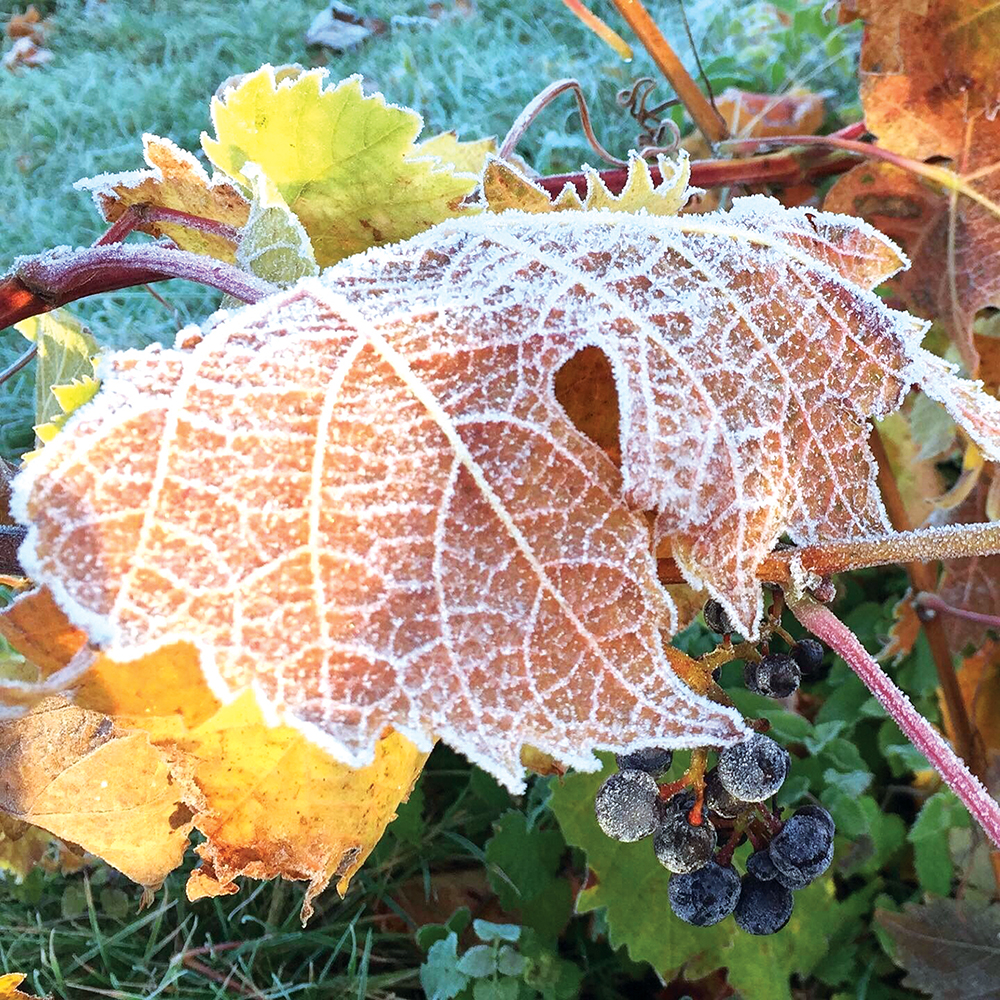
How can you reduce the risk of frost?
The best frost protection technique starts with a good site, but even these can succumb occasionally. Breaky Bottom vineyard, not far from the Sussex coast, experienced its first ever commercial losses in 45 years during the severe frosts in May 2020, losing over 80% of their crop!
“There are a number of passive measures that can be taken. If a site is likely to have a problem, then planting varieties that are naturally late in breaking out of dormancy would be advantageous. For example, Chardonnay is the most susceptible of the ‘Champagne’ varieties because it breaks bud the earliest and Meunier the least susceptible as it is the last to break dormancy,” explained Stephen Skelton.
Keeping alleys clean and mown around bud burst avoids obstructing the flow of cooler air to lower levels. “Long, un-mown grass, which holds moisture, is the worst alleyway cover and likely to make frost damage worse,” Stephen added.
Other methods to reduce the risk of frost damage include pruning later in the spring to delay bud-burst slightly, leaving canes long in a vertical position or leaving additional sacrificial canes. Spur pruning is not common in the UK, but this can be considered for frost prone sites as the mature wood offers some protection. “Vertical canes are less likely to be damaged than horizontal ones, as the frost cannot settle on them, but there is a risk of knocking off the young shoots when tying down and the job of tying down is slower, “ commented Stephen. Mechanical pre-pruning can leave sacrificial canes and allow the final manual pruning to be delayed as late as feasible. A higher fruiting wire might just buy a little extra warmth also.
Dr Alistair Nesbitt is a Viti-Climatologist, based in the UK, and an expert in how weather and climate interface with wine production. Speaking at a WineGB webinar, Alistair explained the importance of “preparing for frost events, understanding the risks in your vineyard, the types of frost and planning accordingly.” Factors affecting the impact of frost include topography, soil moisture vine phenology, and temperature inversion strength. But Alistair warns, “there is no magic solution and no 100% guarantee. What works one year, in one location, may not work in another year.” Alistair therefore recommends an approach of ‘layered’ frost protection, with a system for protecting against classic radiation frost, along with a back-up system for colder temperatures. “VineScapes offer a ‘Frost Risk Audit’ service which provides historic data for a vineyard along with a site risk assessment and analysis of past frost damage patterns. We supply a tailored report with site specific recommendations to mitigate future frost events, including equipment recommendations, as required,” explained Alistair.
Ben Kantsler, Vineyard Manager of one of the largest estates, Nyetimber, has over 150 hectares spread over eight sites. “We carefully map the cold areas, so that we can then decide where we will need to have protection in place and what type. We have a wide range of frost protection methods including frost busters, fans and bougies, depending on the site. We can’t use the frost busters at vineyards with close neighbours due to the noise, so we use bougies,” commented Ben. “We prune late in the more frost risky areas and may leave sacrificial canes,” he added.
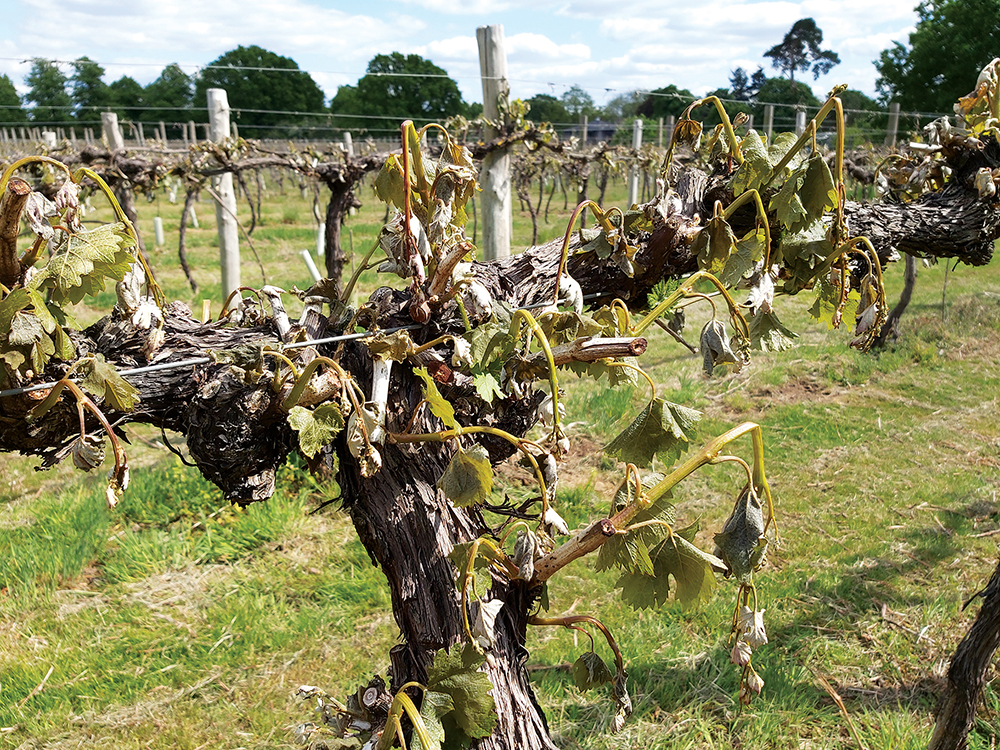
Frost candles
Frost candles, also known as bougies are probably the most commonly used form of frost protection in the UK. They work by introducing lots of small sources of heat into the vineyard, which is more effective that one larger source. Most are now using fats or waxes from sustainable sources. Although there are no capital costs, there is a cost of the candles and the labour needed to light them during the night. The manufacturers state that around 200- 500 candles are recommended per hectare, depending on the situation, but hopefully they are only needed in the frost prone areas of the vineyard. “Stopgel Green was launched in 2016 and these candles contain stearin which is 100% natural. In fact, the calorific value is higher than with the previous petroleum-based candles so they generate a little more heat,” explained Cédric Chazalet.
Matt Strugnell, vineyard manager at Ridgeview Estate, in East Sussex, uses frost candles and has also been trialling electrically heated fruiting wires. “We have been using Stopgel Green bougies and will also try a new company this year, the Crop Candle Co, just to compare. I am keen to ensure that the candles are as sustainable as possible and the fats responsibly sourced,” said Matt. Matt monitors the weather forecast, using a company called Frosted Earth, and also the ClimateVine app, which he has found reliable. “We have a weather station from Soil Moisture Sense to monitor temperature as well as the forecasts, and are on alert and ready to go if temperatures start to drop,” added Matt.
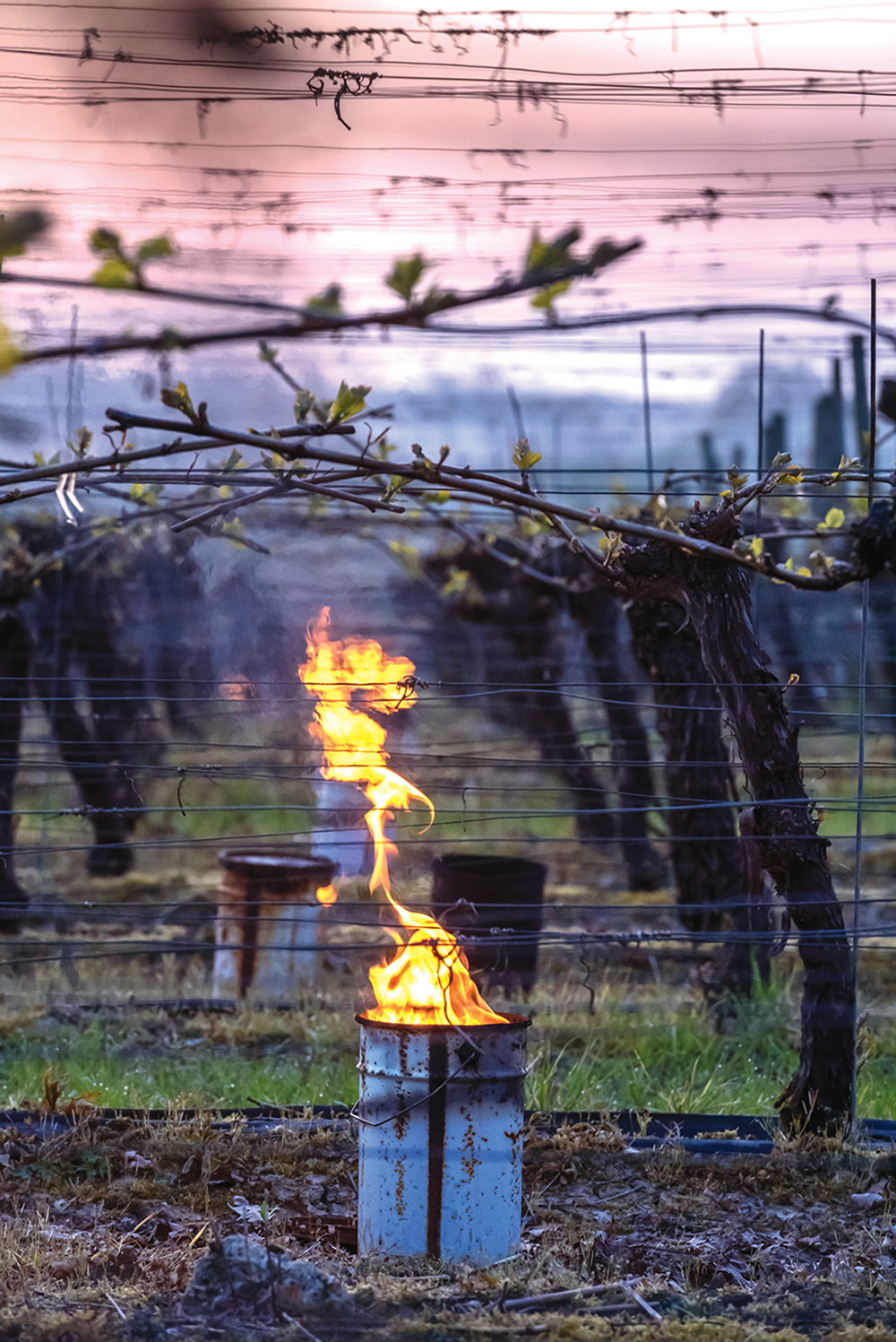
Frost Buster and Frost Guard
If you do not mind spending your night driving around the vineyard, then the Frost Buster is an effective way of raising the temperature by pumping out warm air, which the manufacturers claim can reach 25m to 30m either side. The supplier, Agro Frost, provides an assessment of the vineyard and suggests a circuit route for the driver. The cost of the unit is around £20,000 but this should cover eight hectares. “We have seen a change in the frost incidences here in the UK and in France over the past few years, with more cold winds from the north and north east. In these situations, the mobile Frost Buster seems to work better than the static Frost Guard in vineyards. We also supply mobile and static wind machines but they need an inversion layer to be effective and can have noise issues,” explained Patrik Stynen, Director, Agro Frost.
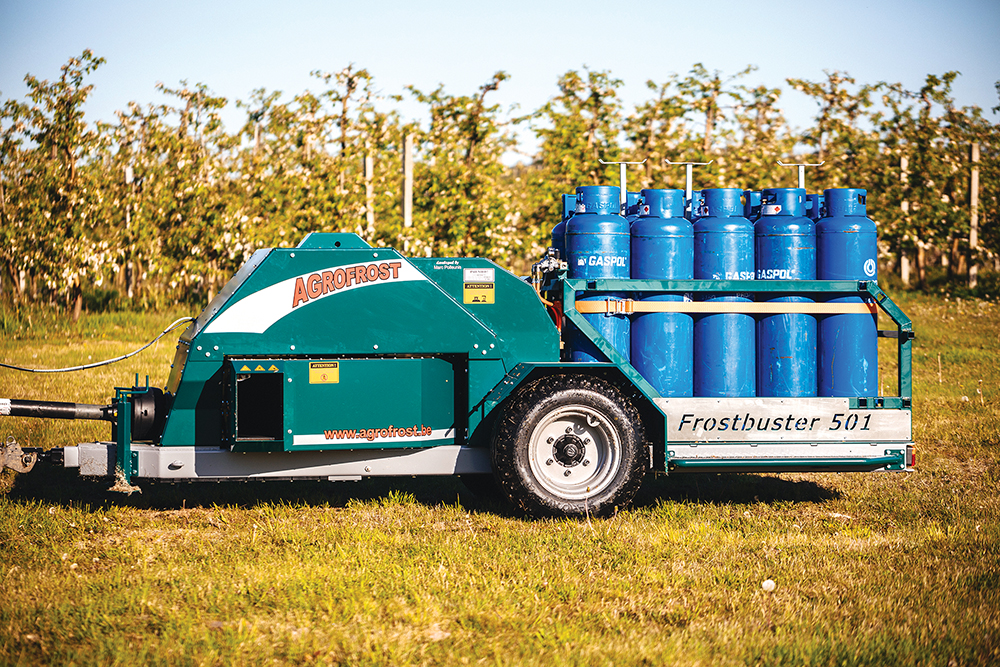
Tow and Blow
As the name suggests the Tow and Blow is a large portable fan towed by a tractor that can be taken to the frost risk area of the vineyard. Using a diesel engine to drive the fan, it draws warmer air from above an inversion layer, blowing it into the vineyard, pushing out the colder air. The fan can also rotate and oscillate. The cost is around £30,000-£35,000 and the manufacturers claim it can cover over four hectares of vines and once temperature parameters are set, it can be left unattended overnight to turn on automatically. One advantage is that there is no installation and planning consent is not needed. It also covers the largest area of any device,” commented Richard Witt from Vitifruit Equipment.
Electric heating cables
These are electric cables running along the fruiting wire that deliver heat. They can be thermostatically controlled and are becoming more common and they work well for classic frost radiation situations. Ridgeview have been trialling heated electric cables on the fruiting wires on five rows of Chardonnay. “We haven’t seen any frost damage as yet, so they seem to work,” said Matt Strugnell, Vineyard Manager. “I think they would be costly across a large area, as the power required to supply the electricity is 10 Watts per metre – I don’t think we would be able to achieve this without a generator,” he added.
Cold Air Drains
These are positioned in the lowest and coolest areas in the vineyard. A large fan inside sucks the cold air up and propels it into the atmosphere. It is effective, if in the right location. However, like other types of fans, this will only work when there is warmer air to draw from.
Overhead sprinkler irrigation
Overhead sprinkler irrigation is reported to be one of the best methods of protection. At the point that water freezes it releases latent heat, keeping the temperature of the grapevine tissue at 0°C, protecting the vine as it is enveloped in ice. This system is rare in the UK for vines but used by some fruit growers.
The advantage of the sprinkler system frost protection is that it works with both radiation frosts and advection frosts and doesn’t rely on an inversion layer of warmer air above the ground.
It has its challenges, such as the quantity of water required, which can be around 30,000 – 50,000 litres/ha/hour. “So you would probably need a reservoir as big as an Olympic sized swimming pool,” commented Alistair Nesbitt. However, there are some trials taking place at NIAB with low volume fan jets, which lowers water use.
Portable ovens
Not yet in the UK, the AntiFrost VOEN is a portable oven that burns wood pellets to heat the vineyard. The ovens can be positioned in the frost risk areas and lit when there is a risk of cold temperatures. They use renewable energy and can be refilled for use year after year. “About 30 per hectare are needed, depending on the situation and the cost is around €300 per unit. The wood pellets can be sourced locally from sustainable sources and are smoke-free,” explained Jakob Fausboell, from Voen. “We have units being trialled in vineyards in Germany, Austria and Switzerland so far the data is showing good results,” he added.
Biostimulants and polymer sprays
Biostimulants contain substances or micro-organisms intended to stimulate the plant and help tolerance to abiotic stress. Lallemand offers a product containing a natural amino-acid which they claim improves the vines tolerance of frost.
Copper sprays, which are fungicide and bactericide, may reduce the population of certain bacteria (such as pseudomonas species) which act as nucleation points for ice on green tissue, and lessen the incidence of frost damage. “It’s difficult to reduce the population of bacteria as there are such vast numbers in the soil, but keeping the herbage around the vines short should help,” explained Rob Saunders. “Polymers are also used, but I haven’t seen much evidence of protection against frost damage. However, I have some confidence in the amino-acid based products, “Rob continued
Frost insurance
NFU Mutual are monitoring the demand for frost insurance as the viticulture sector in this country grows and develops. “Currently, demand for frost insurance for vineyards is low and other risk management techniques for dealing with late frosts are generally favoured by vineyard owners. In order to create a workable insurance market for any given risk, there needs to be a baseline and consistent level of demand for the cover, or the net result is a market that doesn’t really work, with high levels of minimum premiums and large excesses, explained David Harrison, NFU Mutual Sector Lead for Farming and Agriculture.
Monitors
There are several options available that measure temperature and send alerts. The monitor systems from Soil Moisture Sense were originally for soil moisture, as the name suggests, but the technology is also able to provide a flexible range of services including electronic rain gauges, humidity and temperature measures. These are sent as reports to the grower’s mobile phones. “The frost alarms are usually sent to several numbers, to ensure that at least one person wakes up,” commented Peter White from Soil Moisture Sense.
And what should you do if your vines are damaged by frost?
As heart-breaking as it may be to witness a frost damaged vineyard, economics will likely dictate the next steps. Removal of the damaged tissues may be more aesthetically pleasing, but there is a labour cost involved, and it may be better to just leave the vines. “The vines are likely to re-shoot, there may be some (smaller) secondary crop, but more importantly the vine will form a canopy, so there will be adequate photosynthesis and carbohydrate storage taking place, and wood to choose for next year’s pruning. As the growth stages are delayed by a few weeks, bud differentiation will take place when the weather is likely to be warmer, encouraging good fruitfulness for the following year,” explained Dr Greg Dunn.
After the late frost incidence in 2020, Matt Strugnell, along with Alex Valsecchi, Vineyard Manager at Albury Organic Vineyard in Surrey, decided to undertake their own trial which they will run over a couple of years, using an area of vines that suffered frost damage. “We have three treatments, firstly ‘do nothing’, secondly remove all shoots to promote secondary buds, and thirdly prune the damaged tissue,” explained Matt. “So far doing nothing looks as good as anything else,” he exclaimed.
Site selection along with good management practice reduces the reliance on frost protection methods which can be expensive and also have an environmental impact. However, it is possible, with climate change, that frost incidences will become more frequent in the late spring and frost damage may not be avoidable, even at a good site. Understanding your vineyard’s topography, where the cold air flows and accumulates in frost pockets, will help planning the protection methods – both passive and active. Technology such as monitors, sensors and alarms, along with weather forecast services will help anticipate frost events. The best solution for your site will likely depend on costs, available resources, practicalities, expected crop values– and forward planning to make sure everything is in place before the frost arrives!

